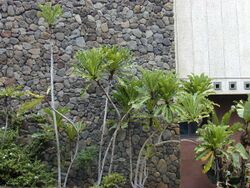Biology:Ficus pseudopalma
| Ficus pseudopalma | |
|---|---|

| |
| Scientific classification | |
| Kingdom: | Plantae |
| Clade: | Tracheophytes |
| Clade: | Angiosperms |
| Clade: | Eudicots |
| Clade: | Rosids |
| Order: | Rosales |
| Family: | Moraceae |
| Genus: | Ficus |
| Subgenus: | F. subg. Sycomorus |
| Species: | F. pseudopalma
|
| Binomial name | |
| Ficus pseudopalma Blanco
| |
| Synonyms[1] | |
|
Ficus blancoi Elmer | |
Ficus pseudopalma is a species of fig in the Mulberry Family (Moraceae).[1] It is known by the common names Philippine fig, dracaena fig, and palm-leaf fig.[2] In nature it is endemic to the Philippines , especially the island of Luzon.[2] It is known elsewhere as an ornamental plant.
This is a shrub growing erect with a naked unbranched mesocaul stem topped with a cluster of leaves to give it the appearance of a palm.[3] Indeed, the species name pseudopalma means "false palm".[4] The leaves are up to 30 -36 inches (75–90 cm) long[5] with a yellow midrib and edged with dull teeth. The fruit is a dark green fig that grows in pairs, each fruit just over an inch long.[3]
In Luzon, this plant occurs in grassland and forest habitat, where it is considered common.[6] The new shoots of the plant are eaten as a type of vegetable, and there are a number of traditional medicinal uses, such as a remedy for kidney stones made from the leaves.[7] In Bicol Region the plant is known as Lubi-lubi and the leaves are cooked in coconut milk.[4] In 2003 the leaves were sold in markets for US$0.74 per kilogram, and the plant can be grown in plantations without pesticides for an adequate profit.[4]
This shrub has been used as a landscaping plant in Hawaii, but it never escaped cultivation or became established in the wild because the species of wasp that pollinates it was never brought to the islands.[3]
References
- ↑ 1.0 1.1 "Ficus pseudopalma Blanco". The Trustees of the Royal Botanic Gardens, Kew. n.d.. https://powo.science.kew.org/taxon/urn:lsid:ipni.org:names:853498-1.
- ↑ 2.0 2.1 {{citation | mode = cs1 | title = Ficus pseudopalma | work = Germplasm Resources Information Network (GRIN) | url = | publisher = [[Organization:Agricultural Research ServAgricultural Research Service (ARS), United States Department of Agriculture (USDA) | access-date = 21 January 2018 }}
- ↑ 3.0 3.1 3.2 Starr, F., et al. (2003). Ficus pseudopalma Fact Sheet. Hawaiian Ecosystems at Risk.
- ↑ 4.0 4.1 4.2 Food & Fertilizer Technology Center. (2003). Fruit and vegetables from the tropical forest. FFTC Practical Technology.
- ↑ Graf, Alfred Byrd (1981). Tropica. East Rutherford, N.J.: Roehrs Company. pp. 1006 & 661.
- ↑ Villegas, K. L. and F. A. Pollisco Jr. (2008). Floral survey of Laiban sub-watershed in the Sierra Madre Mountain Range in the Philippines. Journal of Tropical Biology and Conservation 4(1) 1-14.
- ↑ Ragasa, C. Y., et al. (2009). Terpenoids and sterols from the endemic and endangered Philippine trees Ficus pseudopalma and Ficus ulmifolia. Philippine Journal of Science 138(2) 205.
Wikidata ☰ Q5446628 entry
 |

